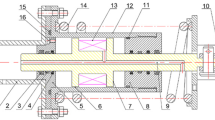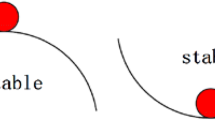Abstract
A vibrating screen is widely used in raw coal screening, but intensive resonance in the startup and shutdown stages shortens the service life of the vibrating screen and generates vibration damage to surrounding buildings. Therefore, we designed a novel vibration isolator based on a magnetorheological damper, aiming to improve the vibration isolation performance of the vibrating screen. The rheological mechanical model of damping force was analyzed based on the Bingham model, and a magnetic circuit was designed according to electromagnetic theory. Then, an experiment was designed to evaluate the vibration isolation performance of the vibration isolator. The results show that the novel vibration isolator, compared with the metal spring ones, reduces the maximum resonance amplitude by 64 % in the resonance region. In addition, the time of passing through the resonance region in startup and shutdown stages is also reduced by 50 % and 60 %, respectively. This study can provide a new method to improve the vibration isolation performance of vibrating screens.
Similar content being viewed by others
Abbreviations
- τ :
-
Shear stress
- τ y :
-
Magnetic shear yield stress
- \(\dot{Y}\) :
-
Shear rate
- η :
-
Dynamic viscosity
- v :
-
Velocity of the piston relative to the cylinder block
- h :
-
Thickness of the damping gap
- F s :
-
Damping force of the MRD in shear mode
- D :
-
Diameter of the piston
- L :
-
Total length of the damping gap
- L 0 :
-
Length of the damping gap
- ΔP :
-
Pressure difference between the two ends of the piston
- A P :
-
Effective area of the piston
- Q :
-
Volume flow rate of MRF between the piston and cylinder barrel
- F v :
-
Damping force of the MRD in flow mode
- F x :
-
Coulomb damping force
- F η :
-
Viscous damping force
- F :
-
Damping force
- N :
-
Turns of the coil
- I :
-
Maximum input current
- ϕ :
-
Magnetic flux
- A f :
-
Area of magnetic induction line flowing vertically through damping gap
- B MR :
-
Magnetic flux density of the MRF in the damper gap
- R m :
-
Equivalent reluctance
- l i :
-
Effective length of each element
- μ i :
-
Magnetic conductivities of each element
- A i :
-
Cross-sectional area of each element
- J s :
-
Current density
- A :
-
Total cross-sectional area of N turns conductor
References
M. F. Eskibalci and M. F. Ozkan, Comparison of conventional coagulation and electrocoagulation methods for dewatering of coal preparation plant, Minerals Engineering, 122 (2018) 106–112.
S. D. Barma, R. Sathish and P. K. Baskey, Ultrasonic-assisted cleaning of Indian low-grade coal for clean and sustainable energy and z. star, Journal of Cleaner Production, 195 (2018) 1203–1213.
L. Peng et al., A more accurate dynamic model for dual-side excitation large vibrating screens, Journal of Vibroengineering, 20(2) (2018) 858–871.
H. Jiang et al., Evolution process and regulation of particle kinematics and spatial distribution driven by exciting parameters during variable-amplitude screening, Powder Technology, 330 (2018) 292–303.
X. L. Yang et al., Vibration isolation analysis of vibrating screen with two-mass and high energy, Applied Mechanics and Materials, 427–429 (2013) 112–115.
S.-L. Wang, Rubber Spring Connector, United States Patent, US20070161265A1 (2007).
H. Jiang et al., Analysis of the static and dynamic performance of metal rubber-spring isolator, China Mechanical Engineering, 13(21) (2002) 1801–1804.
K. Jin, Y. Kou and X. J. Zheng, The resonance frequency shift characteristic of Terfenol-D rods for magnetostrictive actuators, Smart Materials and Structures, 21(4) (2012) 1–7.
R. M. Jolly, J. W. Bender and J. D. Carlson, Properties and applications of commercial magnetorheological fluids, Journal of Intelligent Material Systems and Structures, 10(11) (2000) 5–13.
J. de Vicente, Magnetorheological fluids: a review, Soft Matter, 7(8) (2011) 3701–3710.
X. Zhu, X. Jing and L. Cheng, Magnetorheological fluid dampers: A review on structure design and analysis, Journal of Intelligent Material Systems and Structures, 23 (2012) 839–873.
X. X. Bai et al., Hysteresis modeling and experimental validation of a magnetorheological damper, Proceedings of Active and Passive Smart Structures and Integrated Systems 2015, 9431 (2015).
Y. J. Cha and A. K. Agrawal, Robustness studies of sensor faults and noises for semi-active control strategies using large-scale magnetorheological dampers, Journal of Vibration and Control, 22(5) (2016) 1228–1243.
C. Spelta et al., Control of magnetorheological dampers for vibration reduction in a washing machine, Mechatronics, 19(3) (2009) 410–421.
D. Y. Lee et al., Performance evaluation on vibration control of MR landing gear, Journal of Physics: Conference Series, 149(1) (2009) 012068.
A. Milecki and M. Hauke, Application of magnetorheological fluid in industrial shock absorbers, Mechanical Systems and Signal Processing, 28 (2012) 528–541.
F. Wu et al., Trispectrum and correlation dimension analysis of magnetorheological damper in vibration screen, Journal of Central South University, 7 (2012) 1832–1838.
B. Ralf and J. Hartmut, Design rules for MRF actuator in different working modes, Smart Structures and Materials, 3045 (1997) 148–159.
Y. Wang, S. Li and W. Meng, Strong coupling analysis of fluid-solid for magnetorheological fluid braking system, Journal of Intelligent Material Systems and Structures, 29(8) (2018) 1586–1599.
R. W. Philips, Engineering application of fluids with variable yield stress, Ph.D. Dissertation of Cakifornia, Berkeley, Calif. (1969).
N. Makris, S. A. Burton and D. P. Taylor, Electrorheological damper with annular ducts for seismic protection applications, Smart Materials and Structures, 5(5) (1996) 551–564.
S. Mohammadi et al., Analytical modeling and analysis of axial-flux interior permanent-magnet couplers, Industrial Electronics IEEE Transactions on, 61(11) (2014) 5940–5947.
E. J. Park et al., A performance evaluation of an automotive magnetorheological brake design with a sliding mode controller, Mechatronics, 16(7) (2006) 405–416.
D. Wang and Y. Hou, Design and experimental evaluation of a multidisk magnetorheological fluid actuator, Journal of Intelligent Material Systems and Structures, 24(5) (2013) 640–650.
Acknowledgments
This work was supported by the National Natural Science Foundation of China (51575512, 52074272) and the Priority Academic Program Development of Jiangsu Higher Education Institutions.
Author information
Authors and Affiliations
Corresponding author
Additional information
Mingzhuang Wu is currently working toward a Ph.D. in Mechanical Engineering at the School of Mechanical and Electrical Engineering, China University of Mining & Technology, Xuzhou, China. His research interests include the design, optimization and control of magnetor-heological dampers.
Fei Chen is a Professor at the China University of Mining and Technology. She received her Ph.D. from the School of Mechanical and Electrical Engineering at China University of Mining and Technology. Her research interests include hydraulic transmission and control, smart structure and system.
Aimin Li is a Professor in the China University of Mining and Technology. He received his Ph.D. from the School of Mechanical and Electrical Engineering at China University of Mining and Technology. His research interests include robot technology in the special environment and energy-saving control of construction machinery.
Ziye Chen is a master of the China University of Mining and Technology. He received his Master’s from the School of Mechanical and Electrical Engineering at China University of Mining and Technology. His research interests include transmission and control of magnetorheological devices.
Nana Sun is a master at the China University of Mining and Technology. She received her Master’s from the School of Mechanical and Electrical Engineering at China University of Mining and Technology. Her research interests include the design, modeling, and control of magnetorheological actuators.
Rights and permissions
About this article
Cite this article
Wu, M., Chen, F., Li, A. et al. A novel vibration isolator for vibrating screen based on magnetorheological damper. J Mech Sci Technol 35, 4343–4352 (2021). https://doi.org/10.1007/s12206-021-0906-4
Received:
Revised:
Accepted:
Published:
Issue Date:
DOI: https://doi.org/10.1007/s12206-021-0906-4




